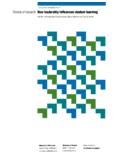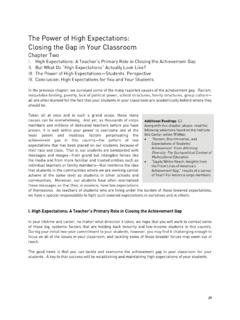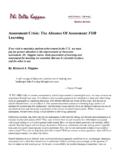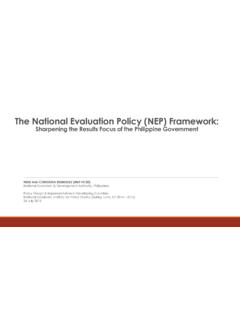Transcription of Key Findings from the Teaching and Learning …
1 JAPAN Key Findings from the Teaching and Learning International Survey (TALIS)1 Teachers in Japan see great benefits to the feedback they receive on their work The great majority (96%) of teachers in Japan work in schools where principals report the use of formal appraisals. The main reported outcome of formal appraisals is to put in place measures to remedy weaknesses in Teaching based on discussions with the teacher. Similarly, almost all teachers in Japan report receiving feedback on their work from multiple actors within their schools, such as the school principal and members of the school management team, using various methods, including classroom observation. More than 80% of teachers in Japan report a moderate or large change in their public recognition, confidence as a teacher, motivation, knowledge of their subjects and Teaching practices after receiving feedback.
2 More opportunities for professional development with a focus on subject content and pedagogy Teachers in Japan are much more likely than their international colleagues to report that they participated in observation visits to other schools and in education conferences and seminars. At the same time, they report relatively high levels of need for professional development for almost all areas surveyed. They show the strongest needs in the areas of knowledge and understanding of their subject field(s) (51%) and pedagogical competencies in Teaching their subject field(s) (57%). Approximately 9 of 10 teachers in Japan point out that professional development activities conflict with their work schedule. To ensure participation in professional development for all teachers in Japan, it is important to ensure employer support and to remove barriers to teachers participation, such as conflicts with work schedule and financial burdens.
3 Promoting the use of a wide variety of Teaching practices Fewer teachers in Japan report the frequent use of various Teaching practices compared with the TALIS average. For example, only 10% of teachers in Japan report that students use ICT for projects or class work frequently or in all or nearly all lessons (compared with 37% on average in TALIS countries). However, in Japan, teachers who report larger proportions of students with special needs in their class are more likely to report the frequent use of practices involving ICT. Encouraging teachers to collaborate to help address their lower confidence in their abilities Teachers in Japan who often collaborate with other teachers in activities such as team Teaching or observing other teachers classes to provide feedback have higher levels of self-efficacy.
4 Therefore, although teachers in Japan show lower levels of self-efficacy across domains compared with the TALIS average (for example, only 16% of teachers in Japan report that they can help students think critically, compared with 80% on average in TALIS countries), encouraging more collaboration among teachers may help enhance the confidence they have in their own abilities. 1 The results presented here represent lower secondary teachers and their school leaders. JAPAN Country Note Results from TALIS 2013 2 OECD The typical teacher, principal and school environment in Japan Typical teacher in TALIS countries Typical teacher in Japan 68% are women Is 43 years old on average 39% are women Is 42 years old on average 91% completed university or other equivalent higher education 96% completed university or other equivalent higher education 90% completed a teacher education or training programme 88% completed a teacher education or training programme Has an average of 16 years of Teaching experience Has an average of 17 years of Teaching experience 82% are employed full time and 83% have a permanent contract 96% are employed full time and 80% have a permanent contract Teaches in a class with 24 students on average Teaches in a class with 31 students on average Typical principal in TALIS countries Typical principal in Japan 51% are men Is 52 years old on average 94% are men Is 57
5 Years old on average 96% completed university or other equivalent higher education 99% completed university or other equivalent higher education 90% completed a teacher education or training programme, 85% a school administration/principal training programme and 78% instructional leadership training 95% completed a teacher education or training programme, 96% a school administration/principal training programme and 94% instructional leadership training Has an average of 9 years of experience as a principal and 21 years of Teaching experience Has an average of 5 years of experience as a principal and 30 years of Teaching experience 62% are employed full time without Teaching obligations and 35% are employed full time with Teaching obligations 98% are employed full time without Teaching obligations and 2% are employed full time with Teaching obligations Works in a school with 546 students and 45 teachers on average Works in a school with 357 students and 24 teachers on average Impact of teacher feedback in Japan Percentage of teachers who report a moderate or large positive change in these areas after they received feedback on their work On average across TALIS countries and economies.
6 Many teachers report positive impacts following feedback they receive about their work, including on their classroom Teaching . Compared with other countries, in Japan, more teachers report that the feedback they received led to positive changes in their Teaching practices (89%), their methods for Teaching special-needs students (63%) or their use of student assessment to improve student Learning (75%). 62 45 59 89 63 75 020406080100 Teaching practicesMethods for Teaching students withspecial needsStudent assessments to improvestudent Learning % TALIS averageJapanJAPAN Country Note Results from TALIS 2013 OECD 3 Participation in professional development (PD) in JAPAN Participation rates and average number of days for each type of professional development in the 12 months prior to the survey Teachers in Japan tend to report higher participation rates than average for PD in two areas during the last year: education conferences (56%) and observation visits (51%).
7 (The TALIS average for these areas is 44% and 19%, respectively.) Teachers in Japan tend to report lower participation rates than average for other PD activities, including in-service training in outside organisations (5%) and attending a qualification programme (6%). Teachers in Japan tend to report spending fewer days than average engaging in PD activities in the past 12 months. On average they report spending five days on courses and workshops (compared with eight days on average for all TALIS countries). Teachers work in Japan Teachers reported working hours per week and distribution of time spent in the classroom during an average lesson Teachers in Japan report spending an average of 54 hours working per week, compared with 38 on average for TALIS countries. The great majority of teachers lesson time is spent Teaching .
8 On average in TALIS countries and in Japan, teachers report spending more than 75% of their class time on actual Teaching and Learning . Teachers in Japan report spending 15% of their class time keeping order in the classroom. Teachers in Japan report spending 18 hours Teaching per week and 9 hours on average for planning their lessons. Teachers in Japan report spending more hours performing a variety of other work-related tasks compared with the TALIS average: for example, they report spending eight hours on average for extracurricular activities (compared with two hours on average for TALIS). 85443276 Average number of days of participation714419143731186056515232360 20406080100%T AL IS a ver ag eJa panCourses / workshopsEducation conferences or seminars Observation visits to other schoolsNetwork of teachersIn-servicetraining in business, public org.
9 ,NGOI ndividual or collaborative researchQualification programme19753322222189554383130102030 TeachingPlanningMarkingAdministrative workTeam workStudent counsellingExtracurricular activitiesOther tasksParents or guardiansSchool managementHours/weekTALIS averageJapan71578 JapanAdministrativetasksKeeping orderin theclassroomActualteaching andlearning81379 TALIS averageJAPAN Country Note Results from TALIS 2013 Contacts: Andreas SCHLEICHER Advisor to the Secretary-General on Education Policy, Acting Director for Education and Skills Telephone: +33 6 07 38 54 64 Tadakazu MIKI Analyst Directorate for Education and Skills Telephone: +33 1 45 24 95 51 For more information on the Teaching and Learning International Survey and to access the full set of TALIS 2013 results, visit: What is TALIS? The Teaching and Learning International Survey (TALIS) collects internationally comparable data on the Learning environment and the working conditions of teachers in schools across the world with the aim to provide valid, timely and comparable information from the perspective of practitioners in schools to help countries review and define policies for developing a high-quality Teaching profession.
10 Cross-country analysis from TALIS enables countries to identify other countries facing similar challenges and to learn from other policy approaches. Recruiting, retaining and developing teachers are vital in ensuring high-quality student outcomes in school systems worldwide. TALIS examines the ways in which teachers work is recognised, appraised and rewarded and assesses the degree to which teachers perceive that their professional development needs are being met. The study provides insights into the beliefs and attitudes about Teaching that teachers bring to the classroom and the pedagogical practices that they adopt. Recognising the important role of school leadership, TALIS examines the roles of school leaders and the support that they give their teachers. Finally, TALIS examines the extent to which certain factors relate to teachers reports of job satisfaction and self-efficacy.

















